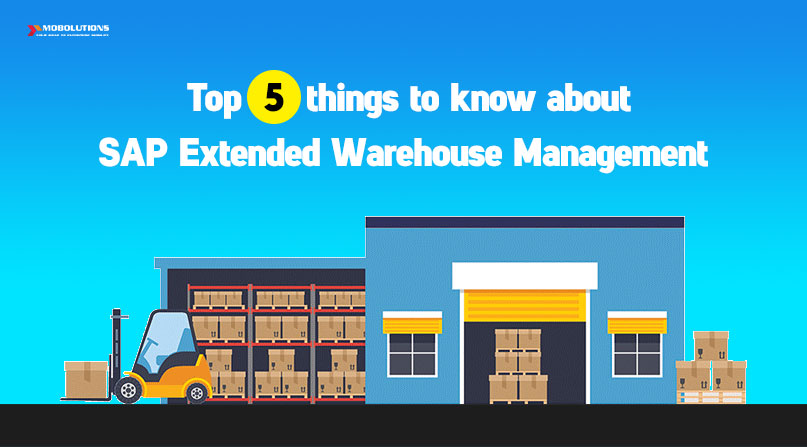What is SAP EWM?
EWM in SAP is a Warehouse system or WMS solution that is the successor to the SAP WM module. The uniqueness of SAP EWM over the SAP WM module has been highlighted in the previous blog ‘SAP Warehouse Management trends – Efficiency Enabler in the Supply Chain’. Here, we are focusing on the industry specific functions supported by SAP Extended Warehouse Management and the latest technology upgrades.
1. WM in SAP: Core Functions and its Features
Inbound Processing
- Transportation unit processing
- Yard Management
- Goods receipt handling and optimization
- Inbound quality management
Integrating technologies: RF, RFID, Voice, Glasses, Material Flow Systems (MFS)
Storage & Operations
- Physical inventory
- Slotting and Rearrangement
- Replenishment
- Kit-to-Stock Management
- Warehouse Billing
Compliance for Exports and Imports, Transit Warehousing & Cross Docking
Outbound Processing
- Outbound Planning (Route, Wave planning, Bin & Cartonization)
- Picking, Packing, Staging, and Loading
- Value-added Services
- Shipping Cockpit
- Transportation Unit
Analytics, Labor Management
2. Types of Warehouses that EWM supports:
Production Warehouse
– For production warehouses, where different parts are assembled for a finished product, the warehouse system caters to raw material handling, QM integration, production supply, receipt from production, staging, and consumption.
Distribution Centre
– The warehouse system supports demand-driven distribution centers for complex, high volume processes with a high degree of automation, wave management, slotting and rearrangement, and replenishment.
Service Parts Warehouse
– The warehouse system meets the needs of low to very high complexity, kitting and value-added services, high volatility, serial numbering, and heterogeneous product ranges.
Cross Dock/ Transit Warehouse
– For cross-docking and transit warehouses, the warehouse system manages regional hubs, gateways, and container freight station, air and ocean freight handling, unit load device and container handling, and receive from/ send to airport/ seaport
3. Fiori for SAP EWM
Introducing process automation means doing away with the manual and paperwork to increase the productivity of warehouse operations and resources. Fiori apps for EWM equips warehouse workers to operate on their mobile devices for almost all major warehouse processes. Here, we look at the Fiori app functions for the two roles listed below.
Warehouse Supervisor
– Can monitor average goods issue delay time, operational reporting of inbound and outbound delivery items, access smart business dashboard based on SAP Fiori Design, and perform real-time analysis via HANA Live.
Warehouse Clerk and Operations executives
– Monitor In/Outbound processing and goods issue with/ without TU and ensure lean and intuitive goods receipt and goods issue processing. Inspect and sort returned products for e-commerce operations and trigger follow-up warehouse tasks, such as putaway or scrap.
There are a number of other Fiori Apps like Assign Fixed Bins, Clear Production Supply Area, Monitor Loading Appointments, and much more that can be leveraged.
4. Industry Specific functions supported by EWM
Automotive
- Production supply
- Kit to stock
- Kit to order
- QM Integration
- MES integration
Chemicals, Oil & gas
- Batch Management
- Dangerous Goods
- Quality Management
Consumer Goods
- Catch weight
- Batch Management
- Shelf-life
- Production and MES Integration
Retail
- Merchandise cross-docking
- High volume business
- Batches and Serial Number
- Catch Weight
Service parts
- Slotting
- Kit to stock
- Kit to order
- QM Integration
- MES integration
Transport & Logistics
- Transport Cross Docking
- Dangerous Goods
- Transit Warehousing
- Warehouse Billing
High Tech
- Serial Number Management
- Production supply
Life Sciences
- Batch Management
- Shelf-life
- QM Integration
5. Latest Technology innovations
There are numerous sensors, motors, devices, and mechanical equipment in a warehouse. Think about all these various points of information that rests in silos and the huge potential if they are integrated with technology. SAP EWM connects and supports mobile devices, RFID scanners, pick by voice, augmented reality, label printers, and scales. IOT also makes it possible for the automation of conveyors, lifts, cranes, and robots, picking systems, Manufacturing Execution System, ASRS &AGV.
Supply chain execution evolves to meet market challenges and evolving consumer demands. WMS solutions will continue to help customers meet challenges by taking an end-to-end view of the supply chain and reinvent operating model execution.
Want to know more about SAP Extended Warehouse Management functions? Get in touch with us!
